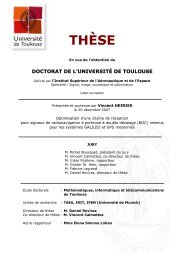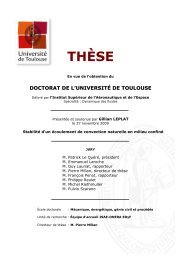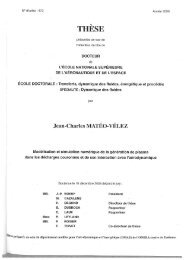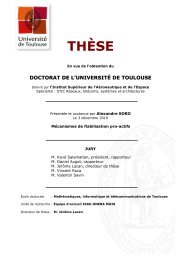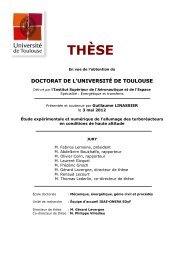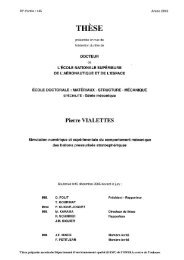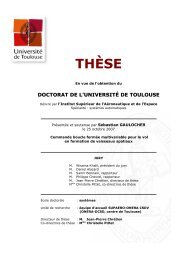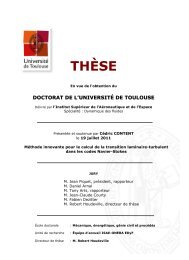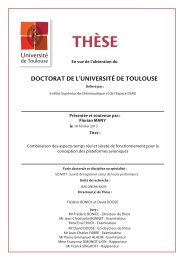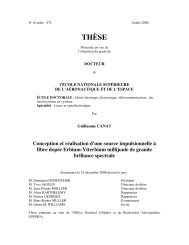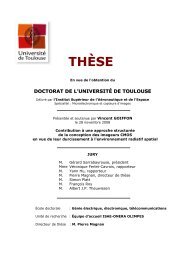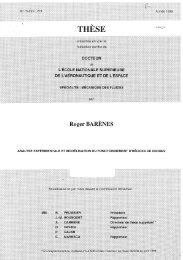Simulation numérique directe de la turbulence en présence d ... - ISAE
Simulation numérique directe de la turbulence en présence d ... - ISAE
Simulation numérique directe de la turbulence en présence d ... - ISAE
You also want an ePaper? Increase the reach of your titles
YUMPU automatically turns print PDFs into web optimized ePapers that Google loves.
<strong>Simu<strong>la</strong>tion</strong> <strong>numérique</strong> <strong>directe</strong> <strong>de</strong> <strong>la</strong> <strong>turbul<strong>en</strong>ce</strong> <strong>en</strong> prés<strong>en</strong>ce<br />
d’une paroi ab<strong>la</strong>table<br />
Résumé<br />
Lorsqu’une son<strong>de</strong> r<strong>en</strong>tre dans l’atmosphère à une vitesse hypersonique, le bouclier thermique<br />
reçoit plusieurs c<strong>en</strong>taines <strong>de</strong> MW.m −2 . Ce flux est absorbé par <strong>la</strong> paroi (composite C/C) grâce à<br />
<strong>de</strong>s réactions physico-chimiques (oxydation, sublimation, etc.). Les expéri<strong>en</strong>ces <strong>de</strong> jet <strong>de</strong> p<strong>la</strong>sma<br />
révèl<strong>en</strong>t que cette perte <strong>de</strong> matière s’accompagne <strong>de</strong> l’apparition <strong>de</strong> rugosités spécifiques lorsque<br />
le régime <strong>de</strong> l’écoulem<strong>en</strong>t est turbul<strong>en</strong>t. Dans ce contexte, cette thèse a pour objectif <strong>de</strong> caractériser,<br />
à <strong>la</strong> plus petite échelle <strong>de</strong> <strong>la</strong> <strong>turbul<strong>en</strong>ce</strong> (échelle <strong>de</strong> Kolmogorov), l’interaction <strong>en</strong>tre l’écoulem<strong>en</strong>t<br />
turbul<strong>en</strong>t et une paroi ab<strong>la</strong>table afin <strong>de</strong> mieux évaluer <strong>la</strong> formation <strong>de</strong> ces rugosités.<br />
La première phase <strong>de</strong> ce travail a ainsi consisté <strong>en</strong> <strong>la</strong> validation physique <strong>de</strong>s phénomènes turbul<strong>en</strong>ts<br />
simulés, d’abord <strong>en</strong> configuration périodique puis <strong>en</strong> prés<strong>en</strong>ce <strong>de</strong> surfaces <strong>de</strong> blocage<br />
pariétal. Pour ce<strong>la</strong>, nous avons développé et adapté à une configuration <strong>de</strong> prés<strong>en</strong>ce <strong>de</strong> paroi,<br />
une métho<strong>de</strong> <strong>de</strong> forçage spectral <strong>de</strong> <strong>la</strong> <strong>turbul<strong>en</strong>ce</strong> dont nous validons l’implém<strong>en</strong>tation. Pour<br />
ce<strong>la</strong>, un traitem<strong>en</strong>t statistique <strong>de</strong>s résultats a été é<strong>la</strong>boré pour pr<strong>en</strong>dre <strong>en</strong> compte le caractère<br />
aléatoire <strong>de</strong> <strong>la</strong> <strong>turbul<strong>en</strong>ce</strong>. L’étu<strong>de</strong> <strong>de</strong> l’évolution structurelle du matériau ab<strong>la</strong>té, couplé à un<br />
champ <strong>de</strong> vitesse turbul<strong>en</strong>t, démontre alors l’influ<strong>en</strong>ce du nombre <strong>de</strong> Reynolds <strong>de</strong> <strong>turbul<strong>en</strong>ce</strong> et<br />
<strong>de</strong> <strong>la</strong> taille <strong>de</strong>s structures porteuses d’énergie, sur <strong>la</strong> vitesse <strong>de</strong> récession <strong>de</strong> <strong>la</strong> paroi et les motifs<br />
rugueux observés.<br />
Mots clés : Ab<strong>la</strong>tion, DNS, Forçage, Turbul<strong>en</strong>ce<br />
Abstract<br />
Direct numerical simu<strong>la</strong>tion of <strong>turbul<strong>en</strong>ce</strong> near<br />
an ab<strong>la</strong>table wall<br />
During the atmospheric re-<strong>en</strong>try the heatshield of the probe suffers a significant overheating.<br />
The composite material un<strong>de</strong>rgoes an ab<strong>la</strong>tive process that consumes the heat flux by physicochemical<br />
reactions (sublimation, oxidation, etc.) and induces the wall disappearance. In the case<br />
of polycrystalline graphite, p<strong>la</strong>sma jet experim<strong>en</strong>ts reveal a structural surface roughness like a<br />
scalloped pattern wh<strong>en</strong> the flow is turbul<strong>en</strong>t. The main i<strong>de</strong>a of this study is to characterize the<br />
interaction betwe<strong>en</strong> a turbul<strong>en</strong>t flow and an ab<strong>la</strong>table material at the Kolmogorov scale (the<br />
smallest turbul<strong>en</strong>t scale) in or<strong>de</strong>r to analyze roughness appearance. First, we have validated the<br />
<strong>turbul<strong>en</strong>ce</strong> simu<strong>la</strong>tion for an infinite domain (periodic boundaries) and for the case of a solid<br />
wall. To this ext<strong>en</strong>t, we have <strong>de</strong>veloped a new way to force <strong>turbul<strong>en</strong>ce</strong> in the spectral space which<br />
is adapted to the solid wall configuration. To this ext<strong>en</strong>t, we have e<strong>la</strong>borated a statistic treatm<strong>en</strong>t<br />
of results as <strong>turbul<strong>en</strong>ce</strong> is an unpredictable ph<strong>en</strong>om<strong>en</strong>a. Th<strong>en</strong>, the evolution of the ab<strong>la</strong>table<br />
surface in interaction with a turbul<strong>en</strong>t flow proves that Reynolds number, wav<strong>en</strong>umber κ e and<br />
flow temperature have a strong influ<strong>en</strong>ce on wall recession velocity and roughness appearance.<br />
Keywords : Ab<strong>la</strong>tion, DNS, Forcing, Turbul<strong>en</strong>ce



